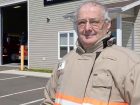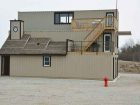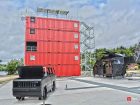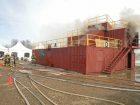
Features
Hot topics
Inside the hall
If you build it . . .
October 2015 - For Miles Boulter, the PEI Firefighters Association school is a field of dreams.
September 29, 2015
By
Laura King
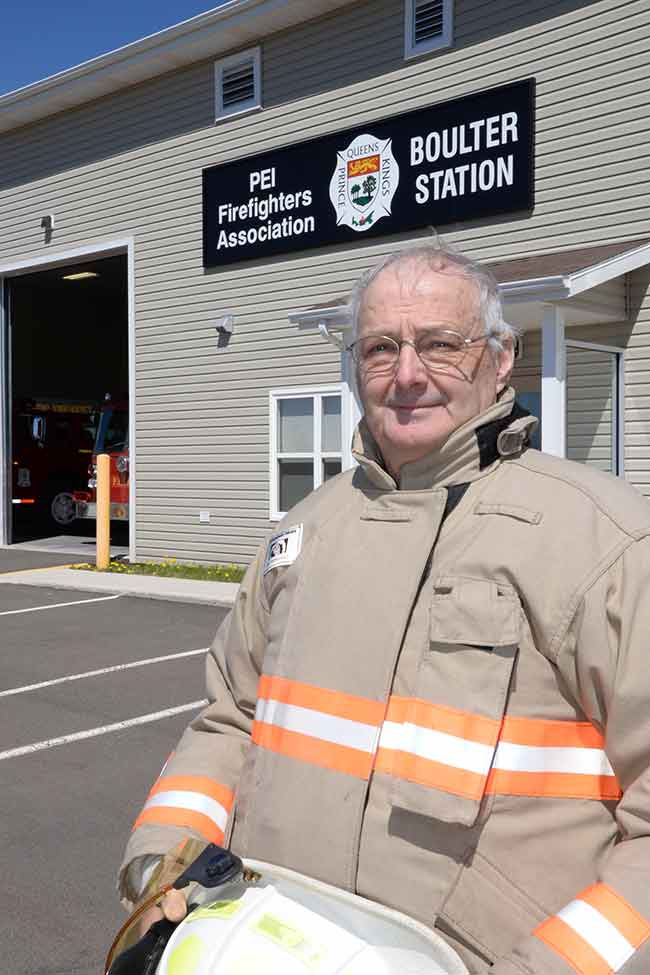 Miles Boulter’s passion for firefighter safety is the driving force behind the PEI Firefighters Association school What
Miles Boulter’s passion for firefighter safety is the driving force behind the PEI Firefighters Association school WhatBoulter, with some help but as the driving force, built the school into the state-of-the-art training ground it is today; and firefighters came – in droves.
The school is named for Boulter, who is, perhaps, Canada’s most modest firefighter. The street on which the school is located is called Miles Boulter Drive, a tribute to P.E.I.’s best-known firefighter, a soft-spoken soul who, as all island firefighters know, is rarely lost for words!
That happened on perhaps only one occasion, back in 2010, when Boulter was named the Canadian Association of Fire Chiefs volunteer chief of the year. His acceptance speech comprised two words: Thank you. (He received the Canadian Volunteer Fire Services Association Lifetime Achievement Award in 2013.)
Boulter’s vision for the island fire school was decades in the making. His passion for training led to the school’s expansion – a live fire simulator, a new confined-space area. Visitors to the school, without exception, are awed by the life-sized model of Boulter’s two-storey home – used for search and rescue training – inside the main training building.
Boulter is at the school every day – Tilley hat firmly planted on his head during the hot island summer – overseeing the training schedule.
His passion for keeping island firefighters safe drives the creative fundraising that has helped to make the school a cutting-edge training ground that serves the needs of the province’s 1,000 firefighters: annual dues, government grants, sponsorships, partnerships.
Boulter has been an island firefighter since 1972; he became the school’s chief instructor in 1991. And he’s sticking around.
As Boulter told the Summerside Journal Pioneer: “One of three things will take place for me to leave; one, it’s no longer fun. The second one is I am no longer physically able to do it and the third and most important one is the first time I tell a student or instructor that ‘we’re doing it this way because we’ve always done it this way.’ At that point I’m no longer moving the association ahead and I will fire myself.”
There are similar training grounds and schools across the country – in Peace River, Alta., Waverley, N.S., Comox, B.C., Meaford, Ont., for example – built by women and men as passionate as Boulter about firefighter safety and willing to champion the cause; funding ingeniously attained, props built by teams of firefighters.
If you build it, they will come.
Comox Fire Training Centre
- Location: 1870 Noel Ave. Comox, B.C., (located behind fire station)
- Website: www.comoxfirerescue.org
- Run by: Comox Fire Rescue, Chief Gord Schreiner
- History: Started in 1997 with a couple of sea containers and has evolved into four permanent structures and hundreds of props.
- Administered and maintained by: Comox Fire Rescue, Chief Gord Schreiner
- Funded by: Some municipal capital; mostly funded through revenue from training.
- Cost: Replacement cost is in excess of $1 million.
- Props/evolutions: Everything! All live-fire props, dozens of others props for TIC, search, auto ex, firefighter survival; everything we need and we’re always adding.
- Live fire? Yes, Justice Institute of BC live fire 1 and 2, seven-room, two-storey concrete burn building (Mrs. Smith house).
- Classrooms: Two; one holds 60 the other 15 students.
- Apparatus: One, 1996 engine.
- Instructors: Yes, lots of very well-trained, seasoned and qualified. They are our best assets.
- Accreditation: NFPA 1001/2 firefighter, live fire, hazmat and some officer programs through JIBC.
- Available courses/programs: Lots; schedules are published twice per year.
- Who/what departments train there? About 500 students per year, mostly from Vancouver Island but also some from other parts of British Columbia and Alberta.
- Successful because? Fire-department managed, a not-for-profit business approach and great instructors working in an innovative fire department and community.
- Future plans: Maintain and enhance programs and facilities.
- Best training moment: Many; I love seeing “real learning” taking place and the big smiles on the students’ faces!
- Three words that describe your training facility: Awesome, innovative, effective.
— Comox Fire Chief Gord Shreiner
Nova Scotia Firefighters School
- Location: Waverley, N.S.
- Website: www.nsfs.ns.ca
- Run by: The fire service in the Province of Nova Scotia by way of a board of directors representing each county in the province, the Nova Scotia Office of the Fire Marshal, Fire Service Association of Nova Scotia in addition to nine members at large.
- History: The Nova Scotia Firefighters School (NSFS) is a not-for-profit society founded in 1967 to address the need for professional fire-service training in the region. NSFS was incorporated under the societies act in 1977. Today the school provides emergency response, industrial, and specialized technical training in support of public safety, governmental, and industrial agencies. The school employs 12 full-time staff at its headquarters in Waverley and 69 part-time instructors and assistant instructors geographically dispersed throughout the Maritime region.
- Since its founding student attendance has consistently increased. In the beginning, there were approximately 200 students annually, increasing to an annual enrolment of 1,000 by the late 1970s. Today’s enrolment is approximately 6,000 per year.
- Infrastructure improvements over the years have allowed for a greater diversity and volume of course offerings. Currently the school is in the process of the installation of nearly $2 million in new infrastructure to expand capacity, course offerings, training fidelity and most importantly safety in training.
- Funded by: The school receives a partial operational grant from the Province of Nova Scotia but primarily operates through course-revenue generation.
- Cost: 2015 operating budget $1.9 million.
- Props/evolutions: The school has dedicated trainers/props for ventilation, hose, forcible entry, confined space, high-rise, hazmat and more. In addition we have a dedicated smoke house, class-A burn building and a new fire-training tower on the way.
- Live fire: NSFS has the capacity to perform class-A, class-B liquid, and LPG fires. There is an existing oil/water-separation pad, class-A burn building, and mobile burn unit. The school is constructing an additional live-fire training tower with three LPG-fired and two class-A fired burn rooms.
- Classrooms: The school has three classrooms with a seating capacity of approximately 120 students.
- Apparatus: Two pumping trucks and one aerial apparatus to support training.
- Instructors: Six full-time instructors and 34 part-time instructors, all are certified to NFPA 1041. Instructors have a wide variety of skills and specialties ranging from post-CBRNE event response to swift-water rescue.
- Accreditation: IFSAC and ProBoard
- Available courses/programs: Including but not limited to Firefighter I and II, confined space, Instructor I and II, ice and water rescue, vehicle extrication, rapid intervention, thermal imager, driver/operator, incident command and safety officer.
- A full list is available at www.nsfs.ns.ca/index.php/courses/
- Who/what departments train there? Training is provided for volunteer and career firefighters throughout the Atlantic region and beyond, industrial fire brigades, the offshore segment in partnership with Falck Safety Services Canada, and commercial and specialty clients.
- Successful because: We are a not-for-profit society owned by, run by, and operated by firefighters for firefighters. We have intensely dedicated, talented, motivated individuals who truly care about and invest in student success.
- Future plans: To improve training and to lead the industry by training in context, challenging ideals, researching, and integrating technology in the learning experience.
- Best training moment: When you see an individual for whom it didn’t come naturally graduate as a competent and capable firefighter due to determination, commitment, study, practice and hard work.
- Three words that describe your training facility: Dedication, knowledge and skill.
— John Cunningham, executive director of the Nova Scotia Firefighters School
Peace River Fire Training Center
- Location: West Hill Industrial Park, Peace River, Alta.
- Run by: Peace River Fire Department and County of Northern Lights Fire Department.
- History: The West Hill training site has been used by the Peace River Fire Department for about 16 years. The site was originally used by the Town of Peace River’s public works department but is now the home of the PRFD/CNL training center. Initially the fire department used the site for vehicle-extrication practice, fire-extinguisher training and some small homemade exterior firefighting props. The site has expanded, and continues to expand, to include hazmat props, ventilation props and multiple large, engineered, interior and exterior live fire props.
- Administered and maintained by: Peace River Fire Department and County of Northern Lights Fire Department.
- Funded by: The Town of Peace River and County of Northern Lights as well as corporate donations, which include Drager Safety Canada, Ruel Brothers Contracting, Blue Wave Energy, Tolko and Ainsworth OSB Mills.
- Cost: Annual training budget of $42,777; we are open to training external clients and renting the facility.
- Props/evolutions: Swede Survival Phase 1 flashover simulator (class-A fuel), used to instruct/observe fire behaviour, flashover recognition/prevention, rollover and fire flow paths.
- Swede Survival Phase 2 flashover simulator (class-A fuel), used to instruct entry procedures, transitional attack, fire flow paths and flashover recognition/prevention.
- Swede Survival Phase 5 multi-level live-fire simulator (class-A fuel), used to instruct fire attack, hose handling/advancing, fire flow-path control, and search-and-rescue techniques with a maze room, multi-floor evolutions, and vertical ventilation.
- Drager tutor fire-extinguisher trainer (LPG fuel).
- Drager System 64 trainer (LPG fuel), used to instruct class-B fire attack, vehicle fire prop, propane tank fire prop and barbecue fire-techniques prop.
- Miscellaneous props: LPG rail-car housing, school bus, ventilation prop, DOT/TC 306/406 tank car, propane tree, SCBA confidence course and widow-bailout trainer.
- Live fire? All LIVE FIRE!
- Classrooms: The classroom is located one block away at PRFD/CNLFD Hall #4. The PRFD/CNLFD command trailer can also be used as an on-site mobile classroom.
- Apparatus: 150-gpm engine, 3,500-gallon tender with a 1,250 fire pump, command trailer, hazmat truck used as medical/vitals station.
- Instructors: Chief Lance Bushie and eight instructors certified to NFPA 1001 Level 2, 1041 Level 1 and 2, 1403 Live Fire Training Fixed Facility Credential and certified by Drager/Swede Survival.
- Accreditation: The PRFD/CNLFD instructional staff are certified to the NFPA 1041 Fire Service Instructor, NFPA 1521 Incident Safety Officer and NFPA 1403 Standard on Live Fire Training Evolutions standards
- Available courses/programs: The PRFD/CNLFD routinely instructs NFPA 1001 Firefighter, NFPA 1002 Fire Apparatus Driver/Operator, NFPA 1051 Wildland Firefighter, NFPA 472 Dangerous Goods Awareness and Operations, NFPA 1006 Vehicle Extrication and Technical Rope Rescue courses.
- Who/what departments train there? In addition to the Peace River and County of Northern Lights departments, multiple departments from northwest Alberta have used this training site. Also, the Peace River Pulp Mill (Diashowa Marubeni) Emergency Response Team has taken training at the West Hill Training Site. We also offer provincially funded regional fire training courses involving departments from northwest Alberta.
- Successful because? Quality of the training props and experience/training of the instructors.
- Future plans: High-angle rescue platform, multi-level fire training unit (class-B, LPG) skills trainer.
- Best training moment: April 30, 2015 – live-fire training at the Peace Regional Fire Conference, as the ops chief and looking over the training ground watching 57 students participating in training, with five live-fire props running concurrently, ICS system in place and running smoothly, Chief Rich Graeber looking at me and giving his fatherly approval.
- Three words that describe your training facility: Professionalism, skill and integrity.
—Peace River Fire Chief Lance Bushie
Meaford Regional Firefighting Training Centre
- Location: 81 Stewart Street, Meaford, Ont.
- Website: www.meaford.ca
- Run by: Meaford Fire Department
- History: Built in 2013
- Administered and maintained by: Meaford Fire Department
- Funded by: Donations from local service groups, firefighters association and council.
- Cost: $173,000
- Props/evolutions: Fully furnished residential apartments. Chimney fire and garage. Approximately 30 various layout options.
- Live fire? No.
- Classrooms: One classroom with seating for 35 students.
- Instructors: Contract instructors as needed.
- Accreditation (NFPA etc): All courses are taught to NFPA standards where applicable.
- Available courses/programs: Basic, advanced and specialized auto extrication, basic emergency management, fire officer level I, fire services instructor I, medical first responder, firefighter survival, introduction to fire prevention, quality breathing air for SCBA administrators and standard first aid.
- Who/what departments train there? Various, open to all departments.
- Successful because? Cost, location and quality of training.
- Future plans: Expand to include the Public Service Health and Safety Association courses such as trench, confined, agri rescue, traffic, etc.
- Best training moment: Quote from a training officer of 24 years regarding firefighter survival course taught here: “This is the best training I have ever received in my career.”
- Three words that describe your training facility: Realistic, effective and qualitative
—Meaford Fire Chief Mike Molloy
PEI Firefighters Association fire school
- Location: 68 Miles Boulter Dr., Milton Station, P.E.I.
- Website: www.peiffa.com
- Run by: PEI Firefighters Association board of directors
- History: Originated 1968 and was slowly built over the years to what we have today; always owned and managed by the firefighters of Prince Edward Island.
- Administered and maintained by: Volunteer chief instructor Miles Boulter and a large group of volunteer assistants.
- Funded by (or how): Small provincial grant ($25,000), commercial training, cost recovery billing to fire departments. Every firefighter in the province is a member of the PEI Firefighters Association; the PEI Firefighters Association owns the school.
- Cost: Annual budget of approximately $300,000
- Props/evolutions: Block house, ladder tower, live fire training simulator, confined-space simulator, interior-building simulator, triple-combination pumper, three classrooms and kitchen facilities.
- Live fire? Yes.
- Classrooms: Three.
- Apparatus: Three (two engines and a hazmat response vehicle).
- Instructors: Chief Miles Boulter and 60 volunteer instructors.
- Accreditation: NFPA
- Available courses/programs: Confined space (awareness, entry, rescue), hazardous materials (awareness, operations, technician), auto extrication, fire attack, pumper operation, instructor techniques, emergency fire-services instructor ( Level I), A volunteer firefighter – A breed apart, Making a difference, fire-service management Level 1, fire extinguishers, defensive driving.
- The PEIFFA school also assists training island firefighters by arranging qualified instructors to train in specialized areas including ice rescue, high-angle rescue and other areas as required. We have recently added medical first responder courses to meet the growing need in the fire service.
- Who/what departments train there?
- Island-wide, 36 departments as well as some from other provinces. Facility also rented to Holland College use for its fire-service program, utilizing our instructors. All provincial Level 1 and 2 practical training is conducted at the fire school.
- Successful because? Dedication of volunteers, good relationship with provincial government and office of the fire marshal.
- Future plans: Additional training props, replacement apparatus. Command simulators.
- Best training moment: Having Chief Alan Brunacini speak at the grand opening of Boulter Station.
- Three words that describe your training facility: Safe, realistic, firefighter-owned.
—Tim Jenkins, past president, PEI Firefighters Association
Print this page
